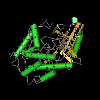?
 
Catalytic domain of the Serine/Threonine Kinase, Calcium/calmodulin-dependent serine protein kinase STKs catalyze the transfer of the gamma-phosphoryl group from ATP to serine/threonine residues on protein substrates. CASK belongs to the MAGUK (membrane-associated guanylate kinase) protein family, which functions as multiple domain adaptor proteins and is characterized by the presence of a core of three domains: PDZ, SH3, and guanylate kinase (GuK). The enzymatically inactive GuK domain in MAGUK proteins mediates protein-protein interactions and associates intramolecularly with the SH3 domain. In addition, CASK contains a catalytic kinase and two L27 domains. It is highly expressed in the nervous system and plays roles in synaptic protein targeting, neural development, and regulation of gene expression. Binding partners include parkin (a Parkinson's disease molecule), neurexin (adhesion molecule), syndecans, calcium channel proteins, CINAP (nucleosome assembly protein), transcription factor Tbr-1, and the cytoplasmic adaptor proteins Mint1, Veli/mLIN-7/MALS, SAP97, caskin, and CIP98. Deletion or mutations in the CASK gene have been implicated in X-linked mental retardation. The CASK subfamily is part of a larger superfamily that includes the catalytic domains of other STKs, protein tyrosine kinases, RIO kinases, aminoglycoside phosphotransferase, choline kinase, and phosphoinositide 3-kinase. |
